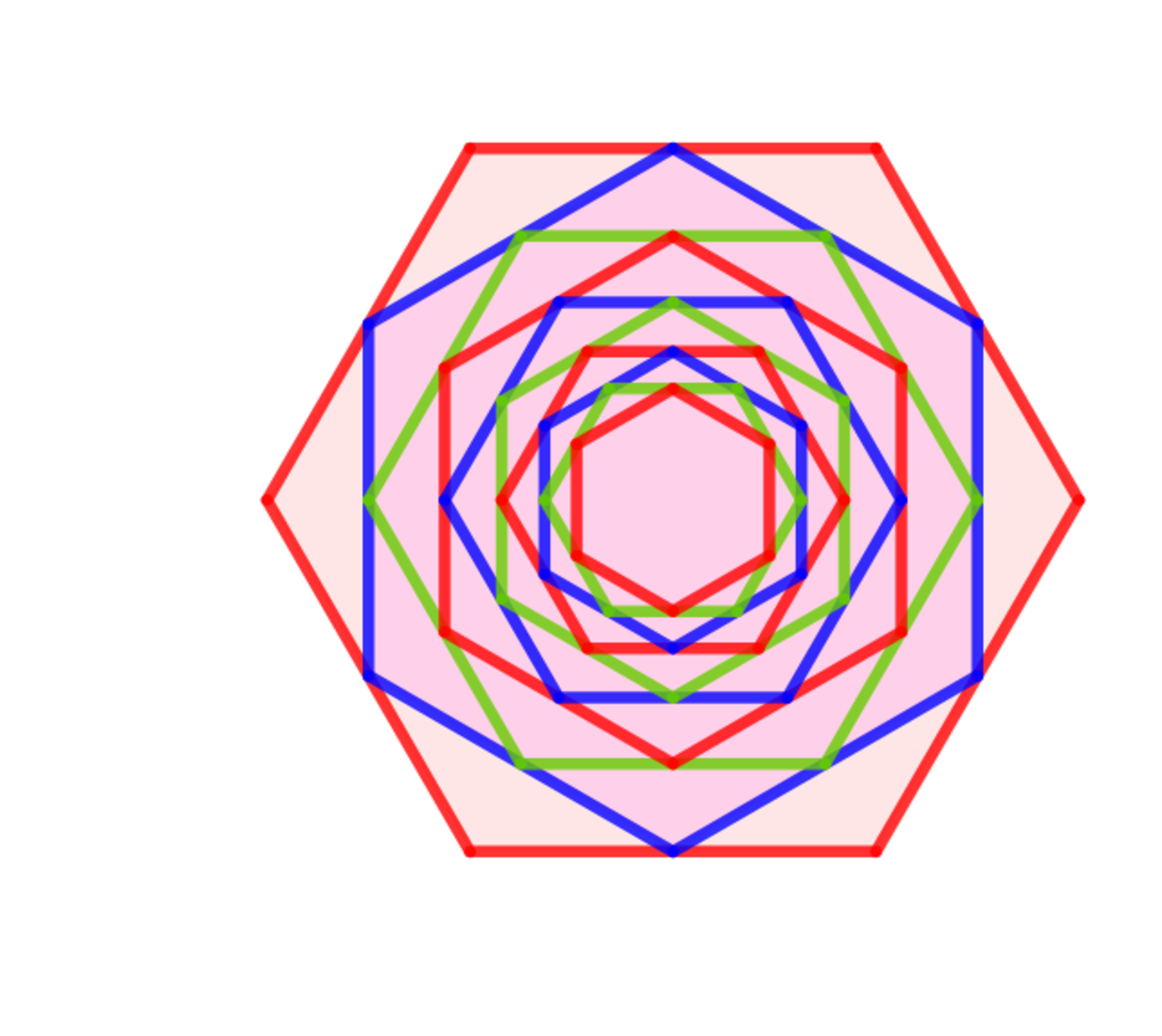Nested Hexagons

Extend the diagram above to an infinite number of inscribed hexagons.
Let H j be the j t h regular hexagon and H j + 1 be inscribed in H j , where each vertex of H j + 1 touches each midpoint of each side of H j .
For j ≥ 0 let A j be the area of j t h hexagon.
If A = ∑ j = 0 ∞ A j , find A 0 A ..
The answer is 4.
This section requires Javascript.
You are seeing this because something didn't load right. We suggest you, (a) try
refreshing the page, (b) enabling javascript if it is disabled on your browser and,
finally, (c)
loading the
non-javascript version of this page
. We're sorry about the hassle.
2 solutions
Let x 0 be a side of the initial hexagon ⟹ the height h 0 of the initial hexagon is h 0 = 2 3 x 0 = x 1
⟹ h 1 = 2 3 h 0 = ( 2 3 ) 2 x 0 = x 2 ⟹ h 2 = 2 3 h 1 = ( 2 3 ) 3 x 0 = x 3 and h j − 1 = ( 2 3 ) j x 0 = x j ⟹ h j = ( 2 3 ) j + 1 x 0 .
∣ ∣ ∣ ∣ ∣ ∣ ∣ ∣ ∣ ∣ ∣ ∣ ∣ ∣ ∣ ∣ ∣ x 0 2 3 x 0 ( 2 3 ) 2 x 0 . . . ( 2 3 ) j x 0 2 3 x 0 ( 2 3 ) 2 x 0 ( 2 3 ) 3 x 0 . . . ( 2 3 ) j + 1 x 0 ∣ ∣ ∣ ∣ ∣ ∣ ∣ ∣ ∣ ∣ ∣ ∣ ∣ ∣ ∣ ∣ ∣
⟹ A j = 6 ( 2 1 ) ( 2 3 ) j ( 2 3 ) j + 1 x 0 2 = 3 ( 2 3 ) 2 j + 1 x 0 2 = 2 3 3 x 0 2 ( 4 3 ) j = ( 4 3 ) j A 0 ⟹
A = ∑ j = 0 ∞ A j = A 0 ∑ j = 0 ∞ ( 4 3 ) j = 4 A 0 ⟹ A 0 A = 4 .
W L O G l e t S o = 1 b e t h e s i d e o f t h e f i r s t h e x a g o n . . A h e x a g o n i s f o r m e d b y s i x e q u i l a t e r a l Δ s , w i t h s i d e = S . ⟹ r a t i o o f c o r r e s p o n d i n g e q u i l a t e r a l Δ s , w i l l b e t h e s a m e a s t h e o n e r e q u i r e d . A s s e e n f r o m t h e s k e t c h t h e s i d e r a t i o s a r e 2 3 . ⟹ a r e a r a t i o s , A 1 / A o = ( 2 3 ) 2 = 4 3 . ∴ w e h a v e a r e a s u m a s : A = 4 3 ∗ { 1 2 + 4 3 + ( 4 3 ) 2 + ( 4 3 ) 3 . . . } = 4 3 ∗ n = 0 ∑ ∞ ( 4 3 ) n . T h i s i s a G . P . s o s u m 1 − r a = 1 − 4 3 1 = 4 . S o A o A = 4 3 ∗ 1 4 3 ∗ 4 = 4 .